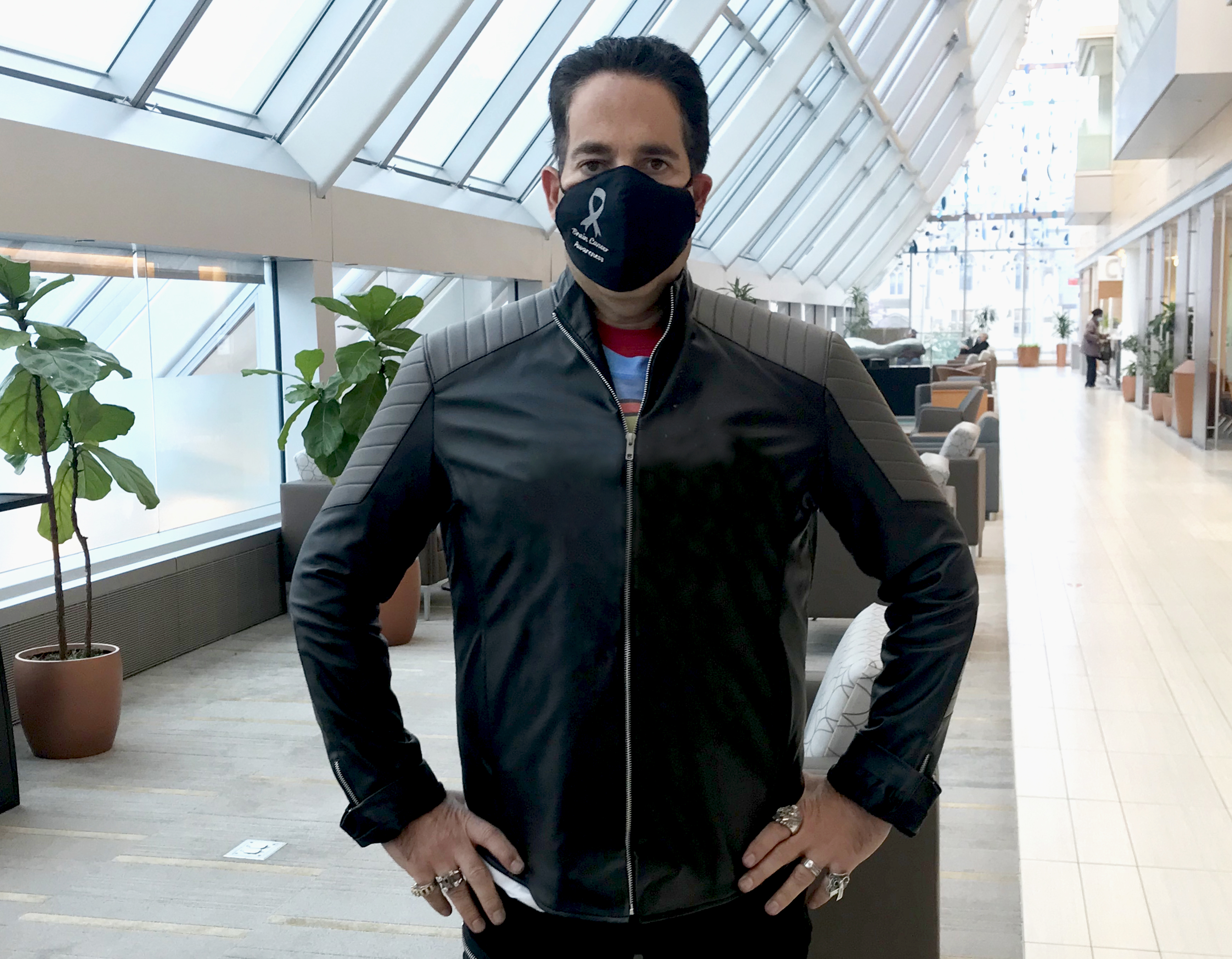Andy “Superman” Simon has cherished each of these milestones since he was diagnosed five years ago with a glioblastoma multiforme (GBM grade 4), one of the deadliest and most challenging cancers to treat. GBM patients typically survive an average of 12-15 months. Only 6.8 percent of GBM patients survive five years, according to the National Brain Tumor Society.
But the Superman of University Hospitals Seidman Cancer Center – who memorably donned a full costume for his final treatment in September 2016 and is free of cancer today with no recurrence – is anything but typical.
“I feel incredible,” says Simon, now 56. “I flew through treatment with ease, because I had the best team and the best surgeon. The way I see it, I had cancer, I don’t have it.”
The crushing headache, similar to a migraine yet inexplicably and mysteriously different, struck early one morning in November 2015. Pulling out of his driveway to head to the ER, Simon was equidistant from two different hospital systems. He and his wife believe that fateful turn to come to UH Ahuja Medical Center, and then UH Seidman Cancer Center, has made all the difference.
“If we hadn’t gone to UH, I honestly believe in my heart that Andy wouldn’t be here today,” said Amy, Simon’s wife.
Neurosurgeon Andrew Sloan, MD, Director of UH’s Brain Tumor & Neuro-Oncology Center and the UH Seidman Center for Translational Neuro-Oncology, diagnosed the large mass in Simon’s brain as a GBM. He performed a craniotomy on Simon using 5-Aminolevulinic Acid (5-ALA), an experimental agent that improves the surgeon’s ability to identify the tumor. Dr. Sloan’s own surgical trial assessing this agent was one of only a handful of studies in the United States at the time, though it is now approved for use throughout the US by the FDA. Simon took the 5-ALA prior to surgery, which causes the cancer cells to glow hot pink, for more complete removal of these aggressive, invasive tumors.
Radiation and chemotherapy are the standard of care following a craniotomy for GBM.
Simon also took advantage of a novel phase I clinical trial that involved genetically engineering his own blood cells to express a mutant protein that made them more resistant to chemotherapy enabling him to safely withstand steadily higher doses of toxic chemotherapy through six rounds. While this phase I trial was designed only to show safety and feasibility, the median survival of the participants was 3.3-fold higher than anticipated based on case-matched historical controls with GBM undergoing standard treatment.
A new clinical trial, funded by a $2.3 million grant from the National Cancer Institute and based on the gene therapy Simon participated in, will open at UH Seidman Cancer Center in the next few months.
“Andy has been a champion,” Dr. Sloan says of the poster-boy for this trial, noting that five-year GBM survivors commonly experience recurrence. “He’s a real fighter.
“This treatment is really a game-changer. This could be the new standard of care. It’s really exciting and very promising.”
For the last several years, Simon has celebrated with a big party complete with a photo display of his milestones. He was planning a blowout celebration this year until the pandemic struck.
“There is hope,” says Simon. “I have too many things to fight for, and to live for. I’ve gotten too far. I’m going to be a statistic for the other side. Every day is a milestone really.”
###
About University Hospitals / Cleveland, Ohio
Founded in 1866, University Hospitals serves the needs of patients through an integrated network of 19 hospitals, more than 50 health centers and outpatient facilities, and 200 physician offices in 16 counties throughout northern Ohio. The system’s flagship academic medical center, University Hospitals Cleveland Medical Center, located in Cleveland’s University Circle, is affiliated with Case Western Reserve University School of Medicine. The main campus also includes University Hospitals Rainbow Babies & Children’s Hospital, ranked among the top children’s hospitals in the nation; University Hospitals MacDonald Women’s Hospital, Ohio’s only hospital for women; University Hospitals Harrington Heart & Vascular Institute, a high-volume national referral center for complex cardiovascular procedures; and University Hospitals Seidman Cancer Center, part of the NCI-designated Case Comprehensive Cancer Center. UH is home to some of the most prestigious clinical and research programs in the nation, including cancer, pediatrics, women’s health, orthopedics, radiology, neuroscience, cardiology and cardiovascular surgery, digestive health, transplantation and urology. UH Cleveland Medical Center is perennially among the highest performers in national ranking surveys, including “America’s Best Hospitals” from U.S. News & World Report. UH is also home to Harrington Discovery Institute at University Hospitals – part of The Harrington Project for Discovery & Development. UH is one of the largest employers in Northeast Ohio with 28,000 physicians and employees. Advancing the Science of Health and the Art of Compassion is UH’s vision for benefitting its patients into the future and To Heal. To Teach. To Discover. is the organization’s unwavering mission. Follow UH on Facebook @UniversityHospitals and Twitter @UHhospitals. For more information, visit UHhospitals.org.
About University Hospitals Seidman Cancer Center
UH Seidman Cancer Center is the only freestanding cancer hospital in Northeast Ohio, where all clinicians and staff are dedicated to the prevention, diagnosis and treatment of cancer while researching new and innovative treatment options through clinical trials. Nationally ranked cancer care is also available to patients through the 11-country region at 18 community-based locations. Our UH Seidman specialists make up 14 cancer-specific teams focused on determining integrated care plans tailored to patient’s needs. UH Seidman Cancer Center is part of the National Cancer Institute (NCI)-designated Case Comprehensive Cancer Center at Case Western Reserve University, one of 50 comprehensive cancer centers in the country. Patients have access to advanced treatment options, ranging from a pioneering stem cell transplant program founded more than 40 years ago and a wide range of immunotherapy to the first and only proton therapy center in northern Ohio for adults and children. Go to UHhospitals.org/Seidman for more information.




